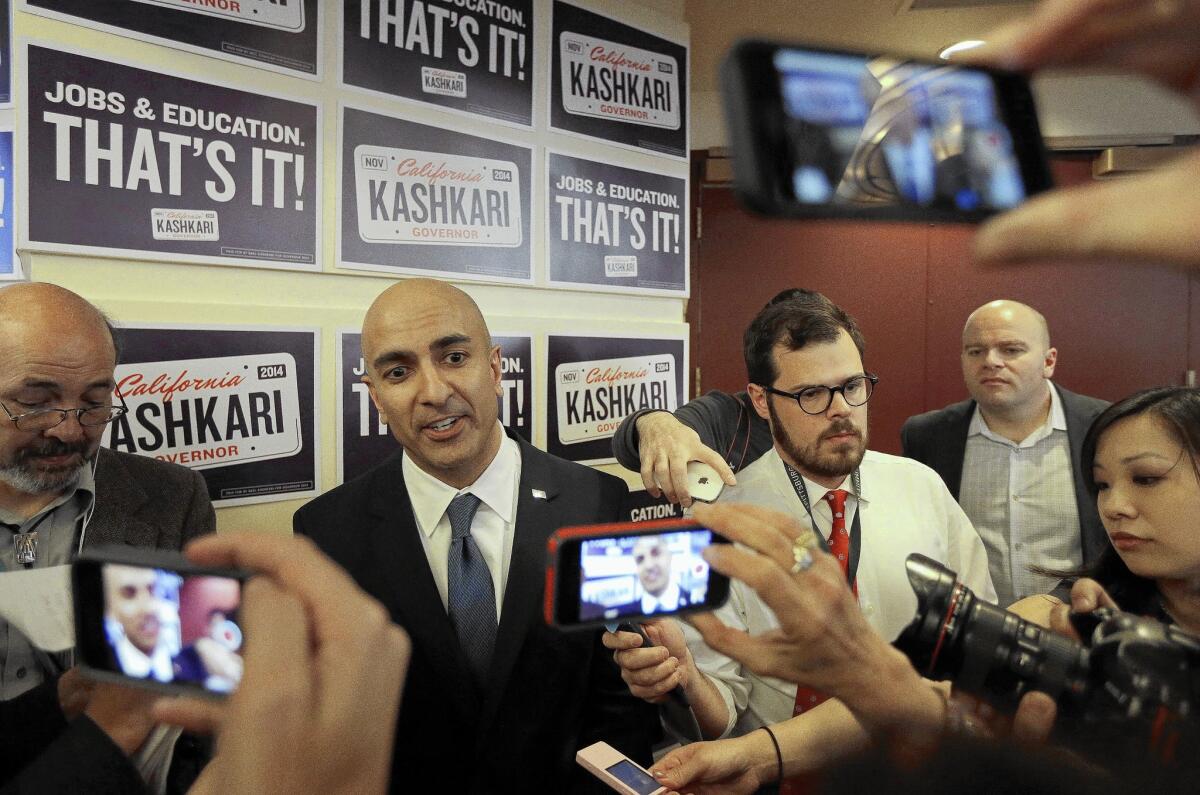Low turnout in California in November could lift prospects for GOP

- Share via
The Democratic Party’s dominance of California is close to a historic peak. But strength can draw trouble.
Although all signs point to an easy reelection for Gov. Jerry Brown in November and million-vote victories for some of the party’s other statewide candidates, the lack of serious competition at the top of the ticket portends low turnout at the polls.
In the June primary, three out of four voters skipped the election — a record low. For Republicans, who tend to do better when fewer voters cast ballots, the prospect of little turnout in November offers a rare opportunity to build an edge in as many as a dozen fiercely contested congressional and legislative races.
“It puts us in the game,” said Republican strategist Tim Clark.
As the campaigns intensify after Labor Day, some of the biggest fights will be in districts where Democrats ousted Republican incumbents two years ago, thanks partly to high voter turnout for the presidential election.
“Turnout in California, primarily on the Democratic side, is a story of boom and bust,” said David Wasserman, who handicaps U.S. House races for the nonpartisan Cook Political Report.
“In 2012, Democrats enjoyed a boom,” he said. “In 2014, there will be a bust. The question is just how much of a bust it will be.”
Prospects for a Democratic takeover of the U.S. House of Representatives are bleak, at best, so the practical effect of the party losing a few California congressional seats would be minimal, analysts say.
At stake in the Legislature, however, is the two-thirds voting supermajority that would allow Democrats to sidestep Republicans if the dominant party wants to raise taxes, override gubernatorial vetoes or place propositions on the statewide ballot.
Democrats are trying to maintain the Assembly supermajority they won in 2012. And they’re battling to regain the one they lost in the state Senate in March amid ethics scandals that ensnared three lawmakers, all on criminal charges and all suspended from their posts.
In the 2010 gubernatorial election, the match between Brown and former EBay CEO Meg Whitman helped draw nearly 6 million more voters than that year’s primary had. But Whitman and Brown spent heavily on TV ads, and their contentious campaign sparked high public interest.
This year, Brown’s GOP challenger, former assistant U.S. Treasury Secretary Neel Kashkari, is little known and so short on money that it’s unclear whether he’ll have enough to buy advertising, introduce himself or attack Brown.
And polls showing Brown about 20 points ahead could fuel public apathy even though general elections typically draw more voters than primaries do.
A lack of emotionally charged ballot measures won’t help.
The one likely to generate the biggest battle — part of a longtime brawl between doctors and lawyers — is Proposition 46. It would raise the limits on pain and suffering awards in medical malpractice cases, a topic with dim prospects for engaging many voters, even with a provision that would require some drug testing of doctors.
For Democrats, a big worry is that many Latinos and younger voters will sit out the election.
“They can swing an election dramatically, because those groups are much more Democratic,” said Ben Tulchin, a pollster for the party’s congressional and Assembly campaigns in California.
But the rapid growth in Latinos’ share of the California electorate — 23% in 2012, up from 10% in 1992 — could keep Democrats from losing ground, said Antonio Gonzalez, president of Southwest Voter Education Registration Project.
More than 600,000 Latinos have registered to vote in California since 2010, U.S. Census figures show. Many of them live in central Orange County, the Central Valley and other areas with close races in November.
With help from organized labor, Democrats have mounted aggressive efforts to register more Latino voters, along with Asians, African Americans and other likely supporters in key districts.
The fruits of those efforts are apparent in the Antelope Valley, where Assemblyman Steve Fox (D-Palmdale) won his seat by just 145 votes in 2012. Since then, the number of registered Democrats in the district has risen by 9,336, while the number of Republicans has increased by 305.
“I don’t take the Democrats lightly,” Republican strategist Kevin Spillane said. “They’re going to put a lot of time, resources and manpower in these races.”
Still, some Republicans are finding success, he suggested, with a less-conservative approach than usual, one that suits a state heavily tilted toward Democrats, particularly on immigration.
One of the party’s leading advocates of immigration reform is freshman Rep. David Valadao of Hanford in the Central Valley. He’s now one of the Democrats’ top targets in California.
But nonpartisan analysts who track House races say most of California’s vulnerable incumbents are Democrats — above all, Reps. Scott Peters of San Diego and Ami Bera of Elk Grove, near Sacramento. Both unseated Republicans in 2012.
“Turnout is key,” said Allan Hoffenblum, publisher of the California Target Book, a nonpartisan election guide. “The lower the turnout, the better it is for Republicans.”
Twitter: finneganLAT
Times staff writers Melanie Mason in Sacramento and Jean Merl in Los Angeles contributed to this report.
More to Read
Sign up for Essential California
The most important California stories and recommendations in your inbox every morning.
You may occasionally receive promotional content from the Los Angeles Times.










